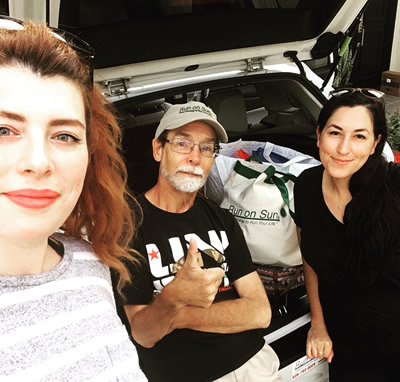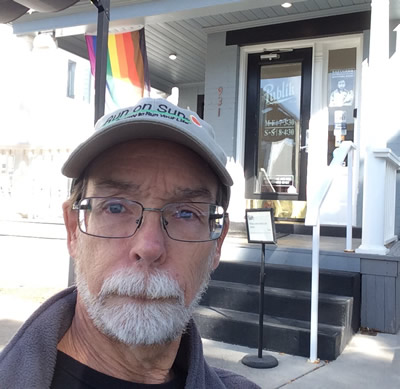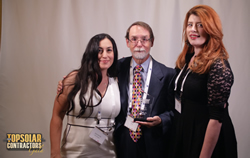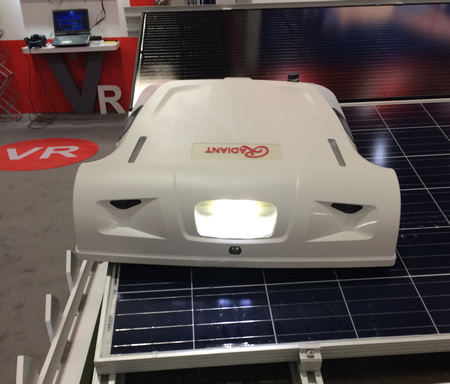Welcome to the
Run on Sun Monthly Newsletter

In this Issue: |
September, 2019
Volume: 10 Issue: 1
Help Give Run on Sun a Boost!Last month we reported on how our long-standing domain name: runonsun.com, got hijacked by persons unknown, and that the domain was now parked with infamous registrar of choice for shady online activities, bizcn.com. Even though they were given evidence proving that the transfer was illicit, they refuse to return the domain name to us. So it looks like runonsun.solar will be our permanent name going forward. Alas, that transition comes with a cost. During the first two weeks of August, just before the hijacking, we averaged 154 visits to the site each day, with a total of 5,269 pageviews. Over the first 14 days of September, we had a total of just 122 visits, 8.7 visits per day! Ouch! We have already uploaded sitemaps to Google and Bing and the site at the .solar domain has been crawled, but it lacks authority, so it ranks very low in the SERPs. For example, our most read blog post ever, "I've got solar; why is my bill so high?" used to rank in the top 5; today it ranks #52 - and how many people go that far? So here is how you can help: if you or your company has a website, or a Facebook or Instagram presence and you have ever linked to any of our content, please have your IT folks edit those links to reflect runonsun.solar, instead of runonsun.com. If everyone who has ever linked to our content were to do that, our back links would grow dramatically, and we would regain much of the authority that we used to enjoy, derived from years of hard work. |
“Please have your IT folks edit those links to reflect runonsun.solar…”
Help Us Spread the News!


SPI 2019 ReviewSeptember 23-26 marked the first-ever Solar Power International (SPI) to be held in Salt Lake City, a questionable choice in the eyes of many. But I have ties to SLC, having earned my M.S. in Computer Science there back in the day, so I was intrigued and excited to make the trip. Here's my take... Park CityIt would not be a trip to SLC without a side venture to the Wasatch Front, so Monday afternoon the three of us headed up to Park City to check out the sites. Of course, this wasn't ski season so it wasn't mobbed like it would be in a couple of months, but that made it all the more enjoyable. Beautiful environs and a lunch that more than made up for the gastronomic nightmare that was Dees the night before. Solar Power World Gala!
On to the Show!We only attend the exhibits—the conference itself got priced out of reach long ago—and several of our friends provided us tickets including LG, Everest, and EnergyToolbase. We greatly appreciate their support. For me, the real point of the show is to touch base with the folks that we already use to learn about anything exciting upcoming, and then be on the lookout for something less familiar that we might want to adopt. Let's start with the familiar: Enphase, LG, and Everest. EnphaseAs has been their recent practice, Enphase did not have a booth at SPI (which are crazy expensive), but their presence was very much there. Most significantly was the executive/installer roundtable that we were invited to attend. About a dozen or so installation companies from across the country were represented in the room, along with most of the Enphase C-suite execs, including CEO Badri Kothandaraman, CFO Eric Branderiz, COO Jeff McNeil, and CCO Dave Ranhoff, along with Marketing VP, J D Dillon. The conversation was frank and informative. The execs were there to hear what was working and what was not, and as to the latter, how to make things better. There was a lot of conversation about handling service requests, and COO McNeil made it clear that cutting wait times was a major priority, even as the installers commented on how much it has improved over the last year, particularly as compared to rival, SolarEdge. There was relatively little talk about Ensemble, but CEO Kothandaraman acknowledged that it was "his call" not to provide backward compatibility with Ensemble and the M-series of older microinverters, noting that it was a question of how long it would have taken to get the product to market if that compatibility had to be included. An understandable, if disappointing, decision to make, but it was good to hear him own it directly. This means that legacy users who want to take advantage of Ensemble, will need to wait until rooftop IQ8's are available, and then upgrade their M-series micros. We shall see how many legacy clients opt to go that route; no doubt cost will be a major factor. LGOur friends at LG continue with their steady roll-out of new products. However, whereas they had been dribbling out products at 5 Watt increments (now you see 340's, now all you see are 335's!), the goal going forward is to make the incremental steps larger. So we anticipate seeing 350's by the beginning of the year in Neon2's, and 370's in NeonR, with more availability of black backsheet models. LG was talking about their new AC module that uses an LG, not Enphase, microinverter - provoking thoughts of deja vu all over again. Frankly, we have not been that enamored of AC modules on pitched roofs, so we aren't inclined to think about this product line from LG. We will continue with our preferred solution of Enphase microinverters and LG modules. EverestEverest has been our racking choice for quite some time, but we have never been a fan of their present end-clamps. So we were quite excited to see their new end clamp that grabs the module frame lip and is completely invisible. We cannot wait to give that new and improved product a try! Of the beaten path…The SPI exhibit hall is huge, and it is next to impossible to cover it completely. But part of the fun is the serendipity of turning a corner and seeing something completely surprising. (This was made a tad more complicated by the twisty, turny layout imposed by the venue - one of the major complaints about the show.) Here's two oddities that caught our eye… Wash me!
The first was this little panel-washing robot. It cost $12,000 and weighs 50 lbs before you add washing solution! That makes it a pricey, and potentially damaging way to clean your panels. But it was very cool to see it crawl its way across an array of clearly sloped panels. Cool tech, but don't think we are investing any time soon. Track me!
But speak of cool tech, this all-mechanical tracker was the cleverest thing we saw. The parabolic mirror (made of metal with a special high reflectance coating that is designed to last 25 years) directs sunlight on a cylinder full of paraffin wax. As the wax heats up, it expands and pushes on a piston.. The piston drives a gear that turns the collection of panels (two in the demo, typically 12 on an actual unit). The sun hits the mirror, the wax expands and heats, pushing the array westward, The sun moves again, back into the parabolic mirror, and the paraffin expands more driving the panels again. When the sun sets, the paraffin cools and contracts, the piston slides in, and the panels return to their east-facing position. Inspired by the heliotropic mechanism of flowers, this design, invented by Fin Doyle of Sulas Industries, was a real stunner. (For folks familiar with the old Zomeworks units, this is similar only in that it is entirely mechanical, but the actual mechanism is completely different.) Not sure if we will ever get to play with one of these -- not a lot of call for poll-mounted systems here abouts -- but we loved finding something new under the sun! |
Short Sellers and Forged SignaturesAs of today, every residential solar installation contract signed in the territory of one of the investor-owned utilities (IOUs), that is SCE, PG&E or SDG&E, must include pages initialed and/or signed from a newly rolled out Solar Consumer Protection Guide. As we wrote back in July in our blog post: California Solar Consumer Protection Guide Hits the Streets, this document serves as a disincentive to add solar, since it makes all solar installers sound like crooks. Noting that we only had ourselves to blame for failing to take a harsher approach to the known bad actors in our industry, I observed, cynically, that the worst players would simply forge the signatures and never even show the document to their customers. Turns out I wasn't being cynical enough. Last week, after we just got back from SPI, word broke of a report by a notorious short seller alleging that a major solar installer was routinely forging customer signatures on contracts and financial documents. Now I don't tend to give short sellers - people who look to profit if a given stock drops in price - a great deal of credence when they allege negative facts about a stock, as the conflict of interest is just too apparent. But then I read the report, and noted that the author linked to some 28 complaints filed around the country against this one company! That's a lot of smoke! (For its part, the installer denies the allegations raised in the report, and presumably in the complaints as well.) I am declining to identify the company only because I do not have independent facts to form an opinion as to the veracity of the allegations, though I'm happy to hear from consumers who do. But the reality is that this sort of conduct is going on, and installation companies are either actively promoting it, or not doing nearly enough to prevent it. Either way, it is a serious black eye for an industry that is supposed to be different - we are supposed to be better. |



